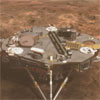
Phoenix has landed on Mars.
In an attempt to uncover clues to the geologic history and biological potential of the Martian arctic, Phoenix will return data from either polar region providing an important contribution to the research on Mars. "Follow the Water" and will be instrumental in achieving the four science goals of NASA's long-term Mars Exploration Program.
--Determine whether Life ever arose on Mars
--Characterize the Climate of Mars
--Characterize the Geology of Mars
--Prepare for Human Exploration
The Phoenix Mission has two bold objectives to support these goals, which are to (1) study the history of water in the Martian arctic and (2) search for evidence of a habitable zone and assess the biological potential of the ice-soil boundary.
The first pictures, which the lander began taking shortly after touching down near Mars' north pole -- the end of a 422 million-mile trek -- showed a pattern of brown polygons as far as the camera could see. The landing on the Red Planet's arctic plains -- which ended a 296-day journey -- was right on target, a feat NASA's Ed Weiler compared to landing a hole-in-one with a golf ball from 10,000 miles. The Phoenix's 90-day mission is to analyze the soils and permafrost of Mars' arctic tundra for signs of past or present life.The lander is equipped with a robotic arm capable of scooping up ice and dirt to look for organic evidence that life once existed there, or even exists now.

The lander took a photo of the ground's polygonal pattern, similar to icy ground in the arctic regions of Earth.SA's Mars Phoenix Lander began sending photos of the planet's surface on the first day of its three-month mission "to taste and sniff the northern polar site's soil and ice," the space agency said.
















0 comments:
Post a Comment